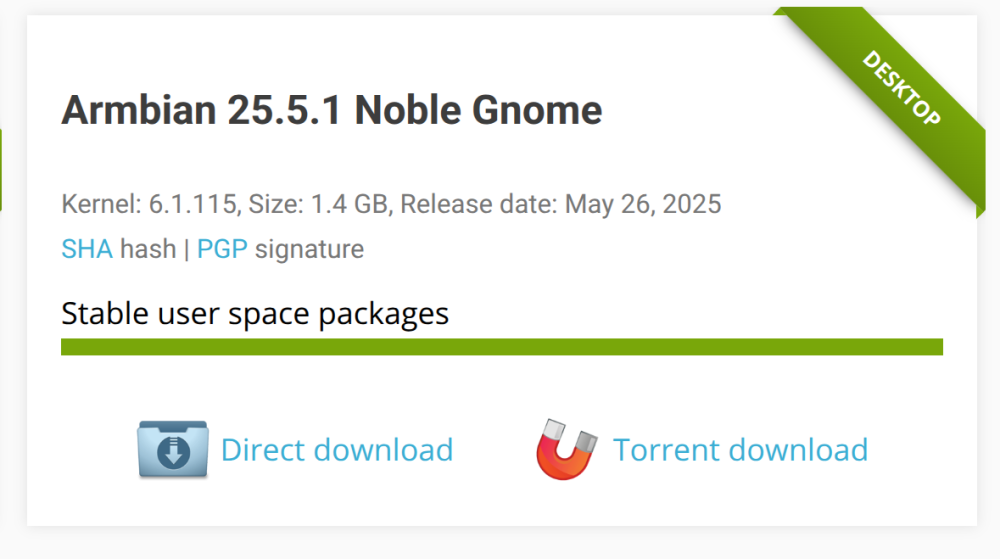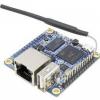Active threads
Showing topics posted in for the last 365 days.
- Past hour
-
Hello, everyone. Armbian website says OnePlus 8t is supported with "standard support" (here: https://www.armbian.com/oneplus-kebab/). I dont know what that includes as it is not very clear. Will one be able to do calls, send messages etc on that phone with Armbian (e.g. similar to sailfish os or ubuntu touch on their respective supported devices). I am basically asking if cellular, wifi, camera etc works fine.
- Today
-
https://docs.armbian.com/Process_Contribute/#adding-a-new-board
-
Heya, No issue here with a rock 5b plus with rkmppenc v0.15 under kernel 6.1.115 on armbian 25.5.1 using HEVC transcoding: acas@rock-5b-plus:~$ rkmppenc -c hevc --preset best --audio-codec aac --vbr 700 -i ~hts/recordings/foo.ts -o ts.mkv -------------------------------------------------------------------------------- ts.mkv -------------------------------------------------------------------------------- [h264 @ 0xaaab23a61de0] non-existing PPS 0 referenced arm_release_ver: g24p0-00eac0, rk_so_ver: 6 rkmppenc (aarch64) 0.14 (r493) by rigaya, Apr 5 2025 09:08:50 (gcc 13.3.0/Linux) OS: Armbian 25.5.2 noble (6.1.115-vendor-rk35xx) aarch64 CPU: Cortex-A76 aarch64 (4P+4E,8C/8T) Input Info: avmpp: H.264/AVC, 1920x1080, 25/1 fps Output: H.265/HEVC main @ Level auto (main tier) 1920x1080p 1:1 25.000fps (25/1fps) avwriter: hevc, #1:mp2/stereo -> aac/stereo/128kbps, #2:aac_latm/stereo -> aac/stereo/128kbps => matroska Quality: best VBR: 700 kbps Max bitrate: 875 kbps QP: Min: 0, Max: 51 GOP Len: 300 frames CHECKPTS: check_pts(1/1): timestamp of video frame is smaller than previous frame, changing pts: -16 -> 2 (previous pts 0). CHECKPTS: check_pts(2/2): timestamp of video frame is smaller than previous frame, changing pts: -24 -> 4 (previous pts 2). CHECKPTS: check_pts(3/3): timestamp of video frame is smaller than previous frame, changing pts: -8 -> 6 (previous pts 4). ^C.8%] 8506 frames: 496.29 fps, 743 kbps, remain 0:05:37, est out size 624.3MB Encoding aborted. encoded 8917 frames, 489.43 fps, 743.66 kbps, 31.62 MB encode time 0:00:18, CPULoad: 0.0% frame type IDR 30 frame type I 30, avgQP 26.73, total size 1.22 MB frame type P 8887, avgQP 30.84, total size 30.40 MB Finished with error in rkmppenc. From looking at your logs, looks like a Device TRee issue - failed to identify key hardware parameters by the looks of it for some reason - change in boot settings? regards Andrew
-

Ugoos AM9 s905x5 ARMBIAN build
Roman Fedorenko replied to Roman Fedorenko's topic in Amlogic CPU Boxes
-
That should be O.K. too.
-
tl;dr; This "only" difference is huge - modern kernel hw specific code is pretty much written from scratch, feature by feature. Not to mention differences in general areas between kernel 6.1 and 6.12, low level boot loader is also usually different. Further reading: https://docs.armbian.com/User-Guide_FAQ/#why-things-stop-working
-
Vendor kernel 6.1.y with mesa-vpu extension https://github.com/armbian/os/blob/main/userpatches/targets-extensions.map#L58 (with patched Chromium) is the only way to come close to what you want. Only this:
-
Welcome to the forum! Your project sounds really interesting and practical, especially for optimizing fleet fuel usage. For an Armbian-based solution, Python is usually the best starting point. It offers great flexibility, extensive libraries, and good community support. Using Python with libraries like Matplotlib for visualization and Pandas for data handling would make it easier to process sensor data and create useful charts. Plus, Python scripts can easily be integrated into your workflow, whether as standalone scripts or through lightweight web interfaces (Flask or Dash, for example). Bash with awk might be lightweight but can quickly get complicated as your project grows—especially when you need calculations and data visualization. As for sensor integration, make sure to check the compatibility and communication protocol (I2C, SPI, UART) of your fuel sensors with Orange Pi. Sometimes the challenge is not only reading accurate data but also filtering out noise and handling sensor calibration. Regarding dashboards, if Grafana feels too heavy or lacking in fuel-specific functions, you might consider building a custom Python dashboard or integrating with lightweight web frameworks that allow tailored features like a dedicated fuel calculator. Looking forward to seeing your startup script and how your project evolves!
- Yesterday
-

Rupa X88 Pro 13 - RK3528 board with images
fedes_gl replied to fedes_gl's topic in Rockchip CPU Boxes
I saw the release of linux kernel 6.16 with initial support for Rockchip RK3528. I hope this update makes more viable to run and configura Armbian on this board 😀 -
Have you tried running sunxi-fw with the boot image you used to extract the dts? The boot image you posted is a U-Boot FIT image. It doesn't have the dram information we are looking for. I believe mmcblk0boot0 is the correct boot image but the one you uploaded didn't work with sunxi-fw. Also, I found this in your dts. Maybe these settings will work. To make sure these settings are correct I prefer to get the dram settings using the sunxi-fw tool. dram { compatible = "allwinner,dram"; clocks = <0xda>; clock-names = "pll_ddr"; dram_clk = <0x288>; dram_type = <0x07>; dram_zq = <0x3f3fdd>; dram_odt_en = <0x9988eeee>; dram_para1 = <0x30fa>; dram_para2 = <0x1000>; dram_mr0 = <0x00>; dram_mr1 = <0xc3>; dram_mr2 = <0x06>; dram_mr3 = <0x01>; dram_tpr0 = <0x00>; dram_tpr1 = <0x00>; dram_tpr2 = <0x00>; dram_tpr3 = <0x00>; dram_tpr4 = <0x00>; dram_tpr5 = <0x00>; dram_tpr6 = <0x2fc08080>; dram_tpr7 = <0x00>; dram_tpr8 = <0x00>; dram_tpr9 = <0x00>; dram_tpr10 = <0x402f3379>; dram_tpr11 = <0xd100b0f>; dram_tpr12 = <0x11131113>; dram_tpr13 = <0x80060>; linux,phandle = <0x183>; phandle = <0x183>; device_type = "dram"; dram_dx_odt = <0x6060606>; dram_dx_dri = <0xd0d0d0d>; dram_ca_dri = <0x1919>; dram_mr4 = <0x00>; dram_mr5 = <0x00>; dram_mr6 = <0x00>; dram_mr11 = <0x00>; dram_mr12 = <0x00>; dram_mr13 = <0x00>; dram_mr14 = <0x00>; dram_mr16 = <0x00>; dram_mr17 = <0x00>; dram_mr22 = <0x00>; }; The dram clock is in hex you'll need to convert this value to decimal. https://www.rapidtables.com/convert/number/hex-to-decimal.html
-
New Linux kernel 6.16 with initial rk3528 support 😁 I hope this helps developing a solid armbian build for this chip and board
-
PanVK has reached another milestone and will be officially supporting Vulkan 1.4 on V10! We're up-to-date with the latest version and are well caught up for this release. View the full article
-

CSC Armbian for RK3318/RK3328 TV box boards
Afsa Jahanara replied to jock's topic in Rockchip CPU Boxes
CSC Armbian for RK3318/RK3328 TV box boards is a community-supported Linux distribution for Rockchip-based TV boxes. Install by downloading the image (e.g., Armbian_23.02.2_Rk3318-box_jammy), burning it to a microSD card using balenaEtcher, and booting the device. Configure via HDMI and keyboard; WiFi may need manual fixes. -
Hi, can anyone help me with this TV box? I need to unlock it, but I don't know where to short the cable because the PC won't connect. Rk3228a, zq01-v1.51
-
Hi and thanks for the reply I have the device running official armbian at my location (already brought it back) and so I'm trying to figure out a way to "simulate" high latency. Any ideas? Otherwise we'll have to wait a few months so I can place it at it's intended location again. As you can imagine, this is something that's taken a LONG time. Many many months and progress is slow.
-
So I have made some progress. A linux kernel for this device (based on the Berlin chipset family) exists at https://github.com/MarvellEmbeddedProcessors. I',m not sure how this piece adds towards creating a functional armbian install tho.
- Last week
-

I Need Best Armbian Setup for Tinker Board (Python + I²C/UART/PWM/GPIO Support)
jock replied to sbcmrt's topic in Tinkerboard
Hello! Asus Tinkerboard is still perfectly supported by Armbian. Best setup is the current LTS kernel 6.12, you can take an image from the official download page: https://www.armbian.com/tinkerboard/ enjoy! -
Thank you for the information I have completed the build dependencies step, for mesa 25.2, in Debian Trixie. However, when I build it, my orange pi zero 3 with 1 GB or RAM, it runs out of memory... even when I make a swap file of 2GB. I keep rebooting the opiz3, and continue the compilation job. Is this normal? In the raspberry forum, they told me that my LCD driver panel-mipi-dbi.ko doesn't work with X11... so I give up on this, and continue my development with labwc/wayland (easily installed in Trixie)
-
Ah, I misunderstood. I thought does not appear at all anymore but the question was about manual call. Has been answered properly already.
-
moved to off-topic we dont support 3rd party os.
-

Composite TV OUT WORKING in Orange Pi One H3, 6.12 current
laibsch replied to Error1429's topic in Orange Pi One
I'm willing to help guide @Error1429 a bit on how to get this done. -
@JuanEsf in case you need testing - I own both OrangePi 4A and Radxa Cubie A5E. So far I tried to build the image from your repo (https://github.com/juanesf/build) - neither board boots for me.
-
The problem is still occurring with the Armbian Bookworm images using the XFCE interface. I closed the topic last year because all the Le Potato Bookworm images had been archived. However, it is now part of the current desktop images listed on the Le Potato page with Armbian Linux v6.12. I tested the Debian 12 (Bookworm) distribution with the XFCE variant, and the issue seen in the archived images—specifically, the missing firefox.conf file—is still present.










